#wight witch
Text
Ghost-Maker Reading List and Order (ultimate cool version by me so its correct)
essential reading/recommended reading/optional reading
Batman v3 (2016) #100 [this is his first appearance, but it's very brief and not necessary to understand the character]
Batman v3 (2016) #102-105 [Ghost-Maker's introduction arc, very important]
Batman v3 (2016) #106-111 [lead-in to the Fear State arc, lots of good moments, the secondary story starting in #107 is Ghost-Maker focused and absolutely essential to understanding him]
Batman v3 2021 annual [my favorite Ghost-Maker story of all time]
Batman Fear State Alpha [he's barely in this, but if you want some context]
Batman v3 (2016) #112-117
Catwoman (2018) #37-38 [I have a fun time with these appearances, but you don't need to read them unless you like the Wight Witch story-line]
Batman Urban Legends #11-13 [he shows up briefly in the Wight Witch 'Stigma' story-line]
Batman Fear State Omega [he's barely in this, but he has such funny lines]
Batman v3 (2016) #118-121 [context for Batman Inc stuff if you want it]
Shadow Wars [an event story that Ghost-Maker shows up in. Find a reading order on the Wikipedia page]
Batman: The Knight (2022) #1-10 [technically he doesn't show up until issue 4, but just read the whole thing. Also this is the most up to date cannon of the backstory, even if I like it less :/]
Batman v3 2022 annual [Batman Inc kick-off]
Batman Incorporated v3 (2022-2023) #1-12
DC Pride (2023) "The Dance"
Misc non-story appearances (you'll be disappointed if you read these for him)
Infinite Frontier #0
Justice League (2018) #75
DC Pride (2021)
DC Pride (2022)
Harley Quinn: Uncovered
DC's 'Twas the Mite Before Christmas
Wildstorm 30th Anniversary Special
Trade Paperbacks
Ghostmaker/Clownhunter [collected issues that mostly feature stuff from the issues I've already mentioned above]
#I will be editing this on occasion#but otherwise this is the best guide#i prommy#ghostmaker#minhkhoa khan#dc comics#dc#pinecone moment#batman#batman comics#ghost-maker#reading list#khoa khan#ghost maker#batman inc#batman incorporated#batman fear state#rhea sinha#wight witch#clown hunter#clownhunter#batman 2016#batman v3#batman the knight#dc pride#batman urban legends#pinecone save
59 notes
·
View notes
Text
What's your opinion on Rhea Sinha aka Wight Witch and would you like to see more of her and her relationship with Khoa and Bruce?
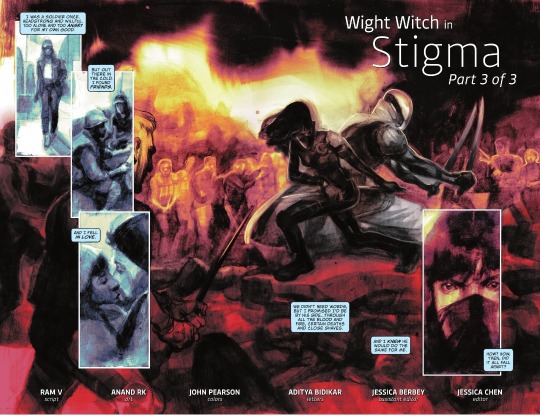

8 notes
·
View notes
Text
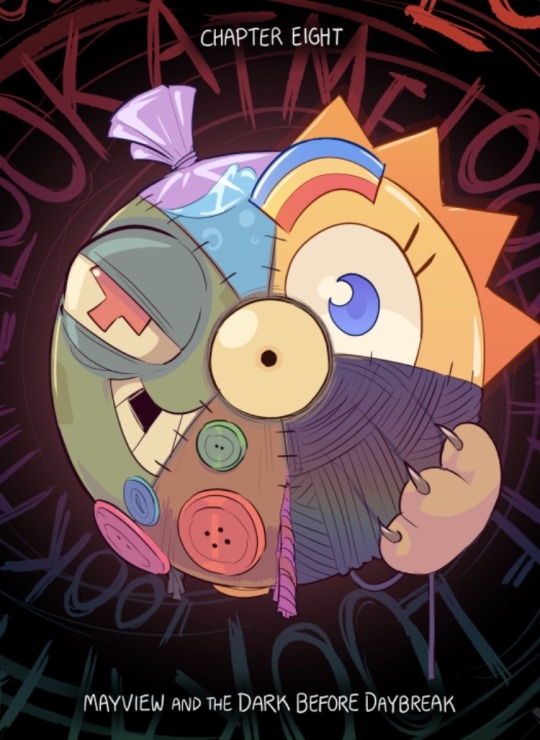
do you think ape doesnt feel any of crush’s hits bc of that evil looking doctopus? bc ive been trying to figure out whats that guys deal/when were gonna see him since the cover page and that feels about right
#theres so much going on there that i wanna know about. whats with the bag of water? whos the sun/rainbows about (i assume suzy??)#the buttons??? like. obviously the yarn and cat paw is the spinx of truth. i assume the buttons and tread is a reference to the witch’s true#form but man. i dont really mnow and were comjng up on the emd of the chapter i assume???#paranatural#oh. and obviously the eye in the center is the wight but like. that was pretty clear from the screaming
64 notes
·
View notes
Text
"The Wraith-lord"
2020

But the Black Captain established a camp at Andrath, where the Greenway passed in a defile between the Barrow-downs and the South Downs; and from there some others were sent to watch and patrol the eastern borders, while he himself visited the Barrow-downs. In notes of the movements of the Black Riders at that time it is said that the Black Captain stayed there for some days, and the Barrow-wights were roused, and all things of evil spirit, hostile to Elves and Men, were on the watch with malice in the Old Forest and on the Barrow-downs.
-"Unfinished Tales of Númenor and Middle-earth", by J.R.R. Tolkien
#witch king#nazgul#barrow wight#lord of the rings#lotr#lotr fanart#lotr art#fandom#photoshop#art#artists on tumblr#mexican artist#autistic artist#dartxo
20 notes
·
View notes
Text
Recently moved and finally have my altars set up and it all feels that much more like home 🖤🖤
#I have two—my main one which has space for Freya and Freyr#then the second one for the land and house wights#personal altar#heathenism#Norse heathenry#witchcraft#eclectic witch
19 notes
·
View notes
Photo

アメリー誕2022
#アメリー・プランシャール#ワイト島分遣隊#ストライクウィッチーズ#イラストレーション#ファンアート#isle of wight detachment group#amelie planchard#strike witches#Fanart#Illustration#painting#drawing
12 notes
·
View notes
Photo

Hey all!
Another token card today!
This is the 2nd of the crones that I wanted to make so people would have a trio of high-level witches for games! The third witch is coming soon!
This is Raine Grimbone, an undead-focused witch that is the Mistress of Wights!
This Token and Card are available for $5+ tier patrons!
#witch#witches#crone#undead#necromancer#bone#bones#wight#dnd#token#tokens#hag#ttrpg#rpg#vtt#foundry#roll20
6 notes
·
View notes
Text



A small signet ring featuring an image of a dour-faced mask: a figure who will guide you through the woods but will snark at you the whole way.
From my Beltane 2024 line, this piece is the third in a series of thematically similar but visually unique pieces that I’m calling “wood wights”. These mask-like images are meant to represent and resemble forest spirits, and would make ideal vessels for magical servitors or familiar spirits. Although some themes may be repeated – this year’s “forest king” and “forest guardian”, for example, are very likely to see future iterations – no two will bear more than a passing resemblance to one another.
1 note
·
View note
Text
Look I’m just saying if people were so eager for a LoTR prequel and the Big Company in charge didn’t care about the materials or the story but just the money, they could’ve just done a look at the world through side characters or peoples we don’t know that much about.
Like, maybe they could’ve made a gritty political drama style thing but it’s from the perspective of the Sackville-Bagginses. Or make a whole story around Bree, I don’t know. But please leave Elrond out of it. Man’s been through enough
#what I really want is maybe something about Tom Bombadill#because I think as a character he’s utterly FASCINATING#or maybe something about the Barrow Wights!#what do we really know about them?#they’re old?#they’re evil?#the swords they got were able to harm the Witch King right?#like#maybe there’s info out there.#but cmon#wouldn’t it be cool to have that instead of what we got?#heck do a background on the Witch King of Angmar#make that Game of Thrones Style#works better than doing it to the elves
1 note
·
View note
Text
Potentially you gotta stop making all those substitutions to the spells, witch bestie.
If you're trying to learn magic and have chosen to do so through other people's published instructional manuals, and the magic isn't working, consider asking yourself if you are actually following the rituals provided.
I've been speaking with multiple people lately who are all struggling with the same thing, so perhaps a post on this topic is germane.
Unless you understand the tradition you're working with and why certain things have certain meanings, you probably do not have the background required to make effective substitutions.
Working within someone else's established tradition is not the same as working within your personal eclectic path.
Imagine you go into a working group which is super into bioregional practice and they've developed elaborate rituals which always work for them.
They give you a purification ritual which calls for a red apple, wild-harvested cotton, and local mulberries to be worked over during a full moon.
They do not tell you why each of these things is included. They just give you the list.
We're going to substitute a store-bought cotton ball, obviously, and what to do about the mulberries? We can google "mulberry correspondences," find out they're related to "healing" which is the closest thing we can figure has anything to do with a purification ritual, then pretty much figure that since chamomile is associated with sleep and purification, and sleep is a Lunar thing, right, that we can just use a sleepytime chamomile tea bag, and there you have it!
What the working group has failed to tell you is that this entire ritual is based on local mythology where the cotton wight fell in love with the mulberry dryad and they got married under the full moon by sharing an apple, and the entire ritual isn't based on sympathetic container magic, but is a heirophany which recreates the marriage of local sacred spirits, each of whom has sworn to heal and purify those who honor their love.
A heck of a lot of witchcraft authors do not break down why every single step is taken.
And if you apply contemporary witch-lite logic to everything ("cotton is white so I'm going to relate that to color correspondences and substitute a white candle for purity"), you can end up immediately canceling out a spell.
Not understanding or connecting with certain spell/ritual steps is not a good reason to change them.
You had mulberries once as a kid and they gave you stomach cramps and now you personally associate them with hexing and sickness, so even though there is a ripe mulberry tree outside, you are going to go get a container of blackberries instead, which you personally associate with purification, and -
(You get the drift)
The spell calls for making a paper box, within which you hide the wild cotton and mulberry. Then, at a crossroads at the full moon, you unfold the box to reveal its contents, and offer an apple to the correspondences.
Which would mean we'd have to learn how to make a paper box (fun!) but also like, why this unfolding thing? Nothing I've read so far in my witchcraft books has explained the magical meaning behind opening a paper box. This is basically a container spell, right? I'll just use a glass jar.
(The plant spirits who informed the local coven about this spellwork specified an opaque, degradable container)
If you're using other people's work, you're more or less sacrificing yourself to the reality that they probably are not explaining everything to you, and that your assumptions about what makes that magic tick could be so far off base that even your most educated guesses will fall short.
Yeah, using other people's traditions can mean you don't have what's required to do everything, and that's kind of just the way it is.
I'm not trying to be Mr. Just Go And Buy Stuff You Moneybags, but I guess I am being Mr. If You Can't Do It Then You Can't Do it.
And no, I'm not saying that it's impossible to figure out substitutions.
I'm specifically referring to a situation where a practitioner is trying to figure out magic, hasn't been able to make strides, and then it turns out they've been radically modifying and altering spells from specific traditions to a point where the spell is obviously functionally DOA.
At one point I was learning some slightly advanced bit of coding. I downloaded a set of files from a code library and installed them on my website.
The thing was, at that point in my education, I had enough experience to basically understand what was going on with each file. So, I edited them as I went, modifying them to my custom specifications.
Wouldn't you know it! When I launched the code it was broken. DOA, if you will.
I went back to the code library, and the top comment was,
INSTALL THE FILES AND MAKE SURE THEY WORK BEFORE YOU TRY TO CHANGE THEM. Everyone keeps changing things before they even test launch it and then they come back here and complain that the code is broken. IT ISN'T BROKEN.
680 notes
·
View notes
Text
Cold Iron in folklore, fiction, and RPGs
'Gold is for the mistress—silver for the maid!
Copper for the craftsman cunning at his trade.'
'Good!' said the Baron, sitting in his hall,
'But Iron—Cold Iron—is master of them all!'
— Rudyard Kipling, “Cold Iron”
Folklore

Drudenmesser, or "witch-knife", an apotropaic folding knife from Germany
The notion that iron (or steel) can ward against evil spirits, witches, fairies, etc is very widespread in folklore. You hang a horseshoe over your threshold to deny entry to evil spirits, you carry an iron tool with you to make sure devils won't assault you, you place a small knife under the baby's crib to ward it from witches, and so on. Iron is apotropaic in many many cultures.
In English, we often come across passages that refer to apotropaic cold iron (or cold steel). "All uncouth, unknown Wights are terrifyed by nothing earthly so much as by cold Iron", says Robert Kirk in 1691, which I believe is the earliest example. "Evil spirits cannot bear the touch of cold steel. Iron, or preferably steel, in any form is a protection", says John Gregorson Campbell in 1901.
Words
So what is cold iron? In this context, it’s just iron. The “cold” part is poetic, especially – but not only – if we’re talking about either blades (or swords, weapons, the force of arms) or manacles and the like. It just sounds more ominous. There are “cold yron chaines” in The Fairie Queene (1596), and a 1638 book of travels tells us that a Georgian general (in the Caucasus) vowed “to make the Turk to eat cold iron”.
Green’s Dictionary of Slang defines “cold iron” as a sword, and dates the term to 1698. From 1725 it appears in Cant dictionaries (could this sense be thieves’ cant, originally? why not, plenty of words and expressions started as underworld slang and then entered the mainstream), and from ~1750 its use becomes much more common.

NGram Viewer diagram for 1600-2019.
In other contexts, cold iron is (surprise!) iron that’s not hot. So let’s talk a bit about metallurgy.
Metals

In nature, we can find only one kind of iron that’s pure enough to work with: meteoritic iron. It has to literally fall from the sky. Barring that very rare occurrence, people have to mine the earth for iron ore, which is not workable as is. To separate the iron from the ore we have to smelt it, and for that we need heat, in the form of hot charcoals. Throwing the ore on the coals won’t do much of anything, it’s not hot enough. But if we enclose the coals in a little tower built of clay, leaving holes for air flow, the temperature rises enough to smelt the ore. That’s called a bloomery.

clay bloomery / medieval bloomery / beating the bloom to get rid of the slag
What comes out of the bloomery is a bloom: a porous, malleable mass of iron (that we need) and slag (byproducts that we don’t need). But now we can get rid of the slag and turn the porous mass to something solid, by hammering the hot bloom over and over. And once the slag is off, by the same process we can give it a desired shape in the forge, reheating it as needed. This is called “working” the iron, hence “wrought iron” objects, i.e. forged.

a blacksmith in his forge, with bellows, fire, and anvil (English woodcut, 1603)
This is the lowest-tech version, possibly going back to ~2000 BCE in Nigeria. If we add bellows, the improved air flow will raise the temperature. So smelting happens faster and more efficiently in the bloomery, and so does heating the iron in the forge, making it easier to work with. And that’s the standard process from the Iron Age all through the middle ages and beyond (although in China they may have skipped this stage and gone straight to the next one).
If we make the bloomery bigger and bigger, with stronger and stronger bellows, we end up with a blast furnace, a construction so efficient that the temperature outright melts the iron, and it’s liquified enough to be poured into a mould and acquire the desired shape when it cools off. This is “cast iron”.
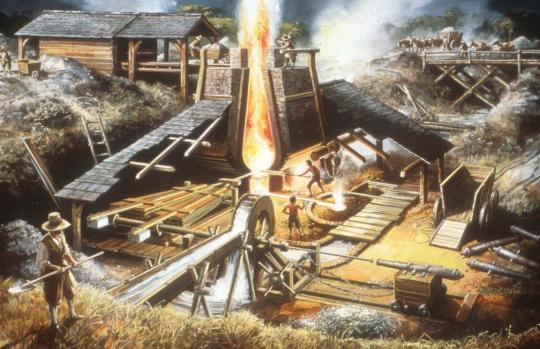
a blast furnace
So in all of this, what’s cold iron? Well, it’s iron that went though the heat and cooled off. (No heat = no iron, all you got is ore.) If it came out of a bloomery, or if it wasn’t cast, it’s by definition worked, hammered, beaten, wrought, and that happened while it was still hot.
Is there such a thing as “cold-wrought” iron? No. In fact, “working cold iron” was a simile for something foolish or pointless. A smith who beats cold iron instead of putting it in the fire shows folly, says a 1694 book on religion, so you too should choose your best tools, piety and good decorum, to educate your children and servants, instead of beating them. When Don Quixote (1605) declares he’ll go knight-erranting again, Sancho Panza tries to dissuade him, but it’s like “preaching in the desert and hammering on cold iron” (a direct translation of martillar en hierro frío).
Minor work can be done on cold iron. A 1710 dictionary of technical terms tells us that a rivetting-hammer is “chiefly used for rivetting or setting straight cold iron, or for crooking of small work; but ’tis seldom used at the forge”. Fully fashioning an object out of cold iron is not a real process – though a 1659 History of the World would claim that in Arabia it’s so hot that “smiths work nails and horseshoes out of cold iron, softened only by the vigorous heat of the sun, and the hard hammering of hands on the anvil”. [I declare myself unqualified to judge the veracity of this statement, let's just say I have doubts.] And there is of course such a thing as “cold wrought-iron”, as in wrought iron after it’s cooled off.
Either way, in the context of pre-20th century English texts which refer to apotropaic “cold iron”, it’s definitely not “cold-wrought”, or meteoritic, or a special alloy of any kind. It’s just iron.
Fiction
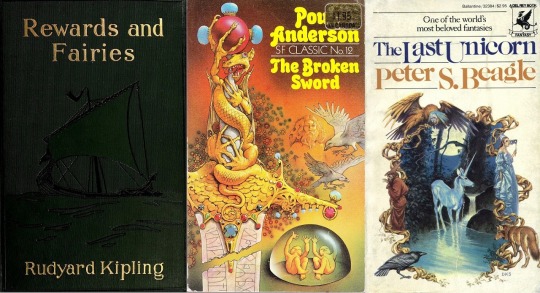
The old superstition kept coming up in fantasy fiction. In 1910 Rudyard Kipling wrote the very influential short story “Cold Iron” (in the collection Rewards and Fairies), where he explains invents the details of the fairies’ aversion to iron. They can’t bewitch a child wearing boots, because the boots have nails in the soles. They can’t pass under a doorway guarded by a horseshoe, but they can slip through the backdoor that people neglected to guard. Mortals live “on the near side of Cold Iron”, because there’s iron in every house, while fairies live “on the far side of Cold Iron”, and want nothing to do with it. And changelings brought up by fairies will go back to the world of mortals as soon they touch cold iron for the first time.
In Poul Anderson’s The Broken Sword (1954), we read:
“Let me tell you, boy, that you humans, weak and short-lived and unwitting, are nonetheless more strong than elves and trolls, aye, than giants and gods. And that you can touch cold iron is only one reason.”
In Peter S. Beagle’s The Last Unicorn (1968) the unicorn is imprisoned in an iron cage:
“She turned and turned in her prison, her body shrinking from the touch of the iron bars all around her. No creature of man’s night loves cold iron, and while the unicorn could endure its presence, the murderous smell of it seemed to turn her bones to sand and her blood to rain.”
Poul Anderson would come back to that idea in Operation Chaos (1971), where the worldbuilding’s premise is that magic and magical creatures have been reintroduced into the modern world, because a scientist “discovered he could degauss the effects of cold iron and release the goetic forces”. And that until then, they had been steadily declining, ever since the Iron Age came along.
There are a million examples, I’m just focusing on those that would have had a more direct influence on roleplaying games. However, I should note that all these say “cold iron” but mean “iron”. Yes, the fey call it cold, but they are a poetic bunch. You can’t expect Robin Goodfellow’s words to be pedestrian, now can you?
RPGs

And from there, fantasy roleplaying systems got the idea that Cold Iron is a special material that fey are vulnerable to. The term had been floating around since the early D&D days, but inconsistently, scattered in random sourcebooks, and not necessarily meaning anything else than iron. In 1st Edition’s Monster Manual (1977) it’s ghasts and quasits who are vulnerable to it, not any fey creature. Devils and/or fiends might dislike iron, powdered cold iron is a component in Magic Circle Against Evil, and “cold-wrought iron” makes a couple of appearances. For example, in AD&D it can strike Fool’s Gold and turn it back to its natural state, revealing the illusion.
Then Changeling: The Dreaming came along and made it a big deal, a fundamental rule, and an anathema to all fae:
Cold iron is the ultimate sign of Banality to changelings. ... Its presence makes changelings ill at ease, and cold iron weapons cause horrible, smoking wounds that rob changelings of Glamour and threaten their very existence.... The best way to think about cold iron is not as a thing, but as a process, a very low-tech process. It must be produced from iron ore over a charcoal fire. The resulting lump of black-gray material can then be forged (hammered) into useful shapes.
— Changeling: The Dreaming (2nd Edition, 1997)
So now that we know how iron works, does that description make sense? Well, if we assume that the iron ore is unceremoniously dumped on coals, it does not. You can’t smelt iron like that. If we assume that a bloomery is involved even though it’s not mentioned, then yes, this is broadly speaking how iron’s been made since the Iron Age, and until blast furnaces came into the picture. But the World of Darkness isn’t a pseudo-medieval setting, it’s modern urban fantasy. So the implication here is that “cold iron” is iron made the old way: you can’t buy it in the store, someone has to replicate ye olde process and do the whole thing by hand. Now, this is NOT how the term “cold iron” has been used in real life or fiction thus far, but hey, fantasy games are allowed to invent things.
Regardless, 3.5 borrowed the idea, and for the first time D&D made this a core rule. Now most fey creatures had damage reduction and took less damage from weapons and natural attacks, unless the weapon was made of Cold Iron:
“This iron, mined deep underground, known for its effectiveness against fey creatures, is forged at a lower temperature to preserve its delicate properties.”
— Player’s Handbook (3.5 Edition, 2003)
Pathfinder kept the rule, though 5e did not. And unlike Changeling, this definition left it somewhat ambiguous if we’re talking about a material with special composition (i.e. not iron) or made with a special process (i.e. iron but). The community was divided, threads were locked over this!
So until someone points me to new evidence, I’ll assume that the invention of cold iron as a special material, distinct from plain iron, should be attributed to TTRPGs.
#long post#cold iron#d&d#Changeling: The Dreaming#World of Darkness#Peter S. Beagle#The Last Unicorn#Rudyard Kipling#Poul Anderson#The Broken Sword#how to rogue#pathfinder#rogues in fiction#Operation Chaos#rogue superstitions#words of the trade#thieves' cant#ad&d#d&d history#1st edition#fey#3.5#fluff#trs
338 notes
·
View notes
Text
Non-comprehensive list of beings who qualify to hinder the Witch King of Angmar:
Not man:
Women (confirmed on page)
Hobbits (confirmed on page)
Elves
Dwarves
Ent
Dragon
Old Man Willow the hungry tree
Beorn in bear form
Treasonous orc
Giant spider
The eagles, the eagles!
A clumsy olyphant
A platypus
Perry the Platypus?!
NO MAN:
Fucking Odysseus what are you doing here get out
Not living:
Ghosts Aragorn brought from the caverns
The barrow wight
GROND GROND GROND
Not man, arguably not living on account of being an angel:
Gandalf
Could if cared to, on account of being Something Else, but it's not his job so he doesn't care to:
Tom Bombadil
2K notes
·
View notes
Text
The Gloaming Tethers

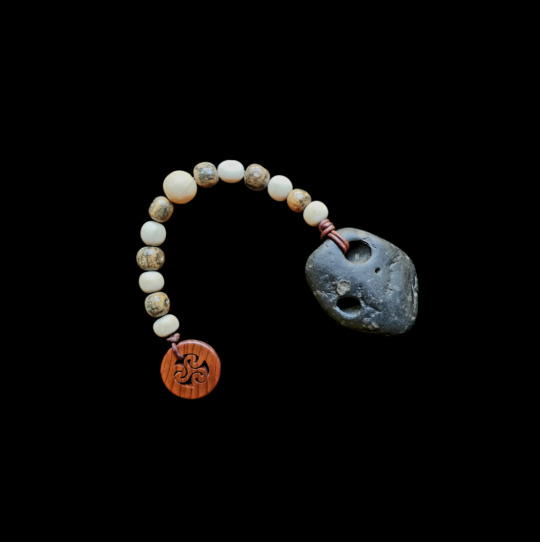
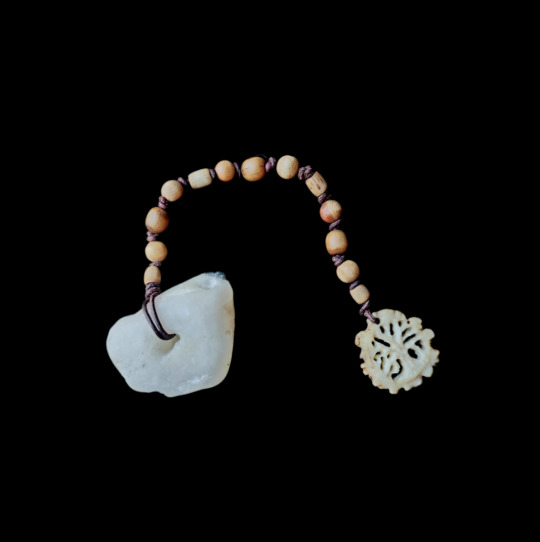
The Gloaming tethers are a pair of ritual fetishes that hold great significance in my personal tradition.
The first of the two pictured here (from left to right) serves a talismanic link to my Witch-Queen—who I often call Bone Mother—and to the Chthonic Realm of the Underworld that she oversees. It was fashioned from a Black Basalt Hagstone, secured by a cord strung with 13 bone beads, including six beads made from Prehistoric Horse Bone, six beads made from Prehistoric Deer Bone, and one bead made from Antique Whale Bone that I inherited. The end-piece is a token of 6,000 year old Bog Yew, carved with a triskelion, and glazed with a wood varnish made using Storax resin. I utilize this Talisman when working with Ancestral Spirits, or with Chthonic Wights, such as psychopomps.
The second of these serves a talismanic link to my Witch-Father—who I often call Wilding King—and to the Upper Realm of the Elemental World that he oversees. It was fashioned from a White Quartz Hagstone, secured by a cord strung with 13 handmade wood beads of alternating Elder, Hazel, Hawthorn, and Rowan. The end-piece is a token of local Elk shed-horn, carved to resembled a great tree, and glazed with a wood varnish made using Amber resin. I utilize this Talisman when working with Animistic Spirits or Elemental Wights.
Each of these Ritual Tethers are sacred to me. They each rest in places of power, pertinent to their respective magical nature, when not in use.
#gloaming tethers#ritual implements#ritual tools#wending way#hagstone#quartz#basalt#spirit work#Wilding King#Bone Mother#Witch-father#witch-queen#witching gods
76 notes
·
View notes
Text
say hello to our 64 niche pink haired characters !!!

after several weeks of deliberation , we've finalized our lineup of characters ! starting on 12 / 17 / 2023 , we'll begin voting to figure out who is the best niche pink haired character of all time !!!
ROUND ONE MATCHUPS
PART ONE - 12 / 17
Kanae Shinjou - Teekyuu VS Misa Maruno - Urahara
Koharu Mitsurugi - Argonavis VS Kei Sarukawa - Charisma House
Christelle de Sarnez - When the Third Wheel Strikes Back VS Penelope Eckart - Villains Are Destined to Die
Jessi Shi - Balala the Fairies VS Riri Hitotsuyanagi - Assault Lily
Kohane Hatoya - Anima Yell! VS Aguri Sakurano - Gamers!
Takara Utashiro - Fairy Ranmaru VS Dr. Doom Jazz - Paradise Killer
Deana del Rio - Double Decker! Doug & Kirill VS Bianchi Law - Helios Rising
Rose - Mysterious Joker VS Misha - Pita-Ten
PART TWO - 12 / 18
Leo Saionji - King of Prism VS Maasa Shirahone - Cute High Earth Defense Club
Alinua - Aurora VS Seren Marsh - Serendipity
Lovrina - Pokemon XD: Gale of Darkness VS Nico - 100% Orange Juice
Miyoi Okunoda - Touhou VS Caro Ru Lushe - Magical Girl Lyrical Nanoha
Liza Wight - Professor Layton VS Kiko Kayanuma - Darker than Black
Shinobu Inuyose - Dig Delight Direct Drive DJ VS Chihaya Anon - Bandori
Chiester 45 - Umineko VS Juna Crawford - Kiseki
Kady Grant - The Illuminae Files VS Peri Dubois - Entropic Float
PART THREE - 12 / 19
Claves - Eternal Sonata VS Hiori Hirahara - Blue Reflection
Lavinia Asimov - Riordan VS Altea Bellerose - Lovestruck
Luna Yumizuki - Cardfight!! Vanguard VS Yayoi Kusakabe - High-Rise Invasion
Miyu Sakurada - Dig Delight Direct Drive DJ VS Kaoruko Moeta - Comic Girls
Zigfried von Schroeder - Yu-Gi-Oh! VS Sakura Kiyashiki - Assassination Classroom
Presea Combatir - Tales of Symphonia VS Tsukumo - Nanbaka
Nene Romanova - Bubblegum Crisis VS Leilani - Reverse 1999
Reona West - Prism Paradise VS Zizel - Witch’s Heart
PART FOUR - 12 / 20
Mercymorn - The Locked Tomb VS Selene Ambrose - Midnight Train
Tsubasa Hamori - Ensemble Girls VS Yamine Renri - UTAU
Bluebell Candy - Magical Girl Raising Project VS Akoyo Gero - Cute High Earth Defense Club
Maria Cadenzavna Eve - Symphogear VS Suzuki Miyu - You and I Are Polar Opposites
Ryuu Zaou - Cute High Earth Defense Club VS Ashu Yuta - B-Project
Chizuru Yakumo - Ensemble Girls VS Aries Spring - Astra Lost in Space
Mangetsu Kohinata - Granbelm VS Azumi Shiratori - Nyanko Days
Araya Endo - Assault Lily VS Amy - Grand Chase
#pink hair swag tourney niche edition#round one#i might have gotten some names mixed up bc i genuinely do not know most of this roster -- pls lmk if this is the case !#i'm so excited for this tourney !!!
116 notes
·
View notes
Text
DC, I'm begging you, please please please please please bring Wight Witch back
A female meta who knew Bruce and Khoa from their training years and probably with the same training!!! Also I want to see more of her with Bruce and Khoa
Give me my Halloween throuple

35 notes
·
View notes